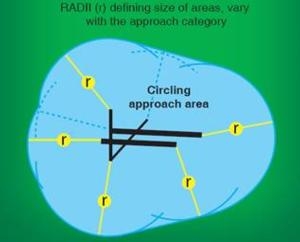Result Of Nearly 20 Years Of Advocacy On The Part Of The Aviation Industry
For nearly 20 years, the aviation industry has expressed to the FAA its concern over spatial limitations of circle-to-land approaches. These safety concerns have been raised by industry representatives who suggest that the amount of protected airspace allowed for aircraft maneuvering throughout a circling approach is insufficient.

As a result, the FAA has increased the size of protected airspace used in establishing the minimum descent altitude (MDA) on circle-to-land approaches. Since May 2, 2013, FAA has begun to publish instrument approach procedures that use the larger circling approach airspace dimensions. This new criteria affords pilots greater lateral obstacle clearance protection and increased maneuvering space to properly align and stabilize the final approach and landing out of a circling approach.
The protected airspace for a circle-to-land approach is defined by arcs of a specific radius based on the aircraft approach category defined in 14 CFR Part-97. These arcs are centered on each runway threshold and connected tangentially to form a continuous block of airspace that the pilot can use to maneuver and align the aircraft with the landing runway (see illustration).
Industry safety groups have long expressed concerns that the radii size used to establish these arcs was insufficient to contain large, jet transport airplanes during the circle-to-land maneuver. These concerns were highlighted following a Boeing 767 controlled flight into terrain accident during a circling approach designed using US TERPS criteria. In addition, the size of the circling approach area did not always allow enough room for pilots to align the aircraft with the final approach and consistently achieve a stabilized approach. “One of the problems that we’ve seen in the past with the circling-to-land approaches is unstabilized approaches – airplanes being too fast and too high at the end of the circling maneuver,” said Richard Boll, a member of the NBAA Access Committee and chairman of the Airspace, Air Traffic and Flight Technologies Working Group. “They end up landing too far down the runway, increasing the chances of a runway excursion.”
Subsequently, the FAA conducted an extensive review that resulted in new TERPS criteria that increases the radii dimensions defining the circling protected airspace. In addition, the radii dimensions increase in size as circling MDA increases. This increase in radii size with higher MDAs accounts for greater true airspeeds and adverse wind gradients encountered at higher mean sea level (MSL) altitudes.
“For CAT C and CAT D aircraft, the protected airspace is going to increase about one nautical mile from what we’ve seen in the past in all instances,” said Boll. “And then, as the MDA increases, we’re going to see an additional widening of the protected airspace by approximately one-tenth of a nautical mile for every 2,000 feet of altitude.” Combined with the overall increase in protected airspace for CAT C and CAT D aircraft, Boll said, an aircraft executing the circling-to-land approach at 8,000 feet MSL would have a total of approximately 1.5 nm more maneuvering room under the new TERPS criteria. While these radii are smaller than those used in ICAOs PANS-OPS, they represent a significant improvement over the previous TERPS criteria.

The FAA reviews all instrument approaches at U.S. airports every two years and as such it will take the FAA a number of years to update all existing approaches to the new criteria and apply the larger circling area dimensions. Operators can expect to see these changes when their airports come up for their review. Circling minima not identified by the "Inverse C" icon continue to use the older circling area dimensions defined by the smaller radii. On these approaches, pilots must ensure that they do not base their circling maneuver on the larger airspace afforded by the new TERPS criteria and risk exceeding the circling protected airspace during the circling maneuver.
Pilots conducting circling approaches based on circling minima annotated with an "Inverse C" may take advantage of the larger circling protected airspace when executing the circling maneuver. For example, a category C aircraft is protected out to 2.7 NM from the runway thresholds at circling MDAs up to 1,000 feet MSL. The protected airspace radius increases by 0.1 NM for every 2,000-foot increase in MDA. While pilots are expected to use the extra maneuvering room to establish a stabilized approach on final prior to landing, they are still expected to remain safely within the confines of the circling protected airspace while executing the circling maneuver. The circling protected airspace provides 300 feet of obstacle clearance at the circling MDA.
An aircraft's approach category is based on 1.30 VSO or VREF, as defined by the certification rules applicable at the time that the type certificate was issued, computed at the aircraft's maximum certificated landing weight. Transport airplanes type-certificated after December 2002 define final approach speed using the term VREF, which was newly added to the definitions contained in 14 CFR part 1. Prior to December 2002, final approach speed for transport airplanes was defined as 1.30 VSO.
Whether final approach speed is defined as 1.30 VSO or VREF, the aircraft's approach category is always based on maximum certified landing weight. It is never permissible to use a lower approach category based on the aircraft's actual landing weight. Non-standard landing configuration or abnormal procedure speed additives may result in the need to use minima associated with a higher approach category. If these lines of minima are not published, then circling approaches are prohibited.
(Image from NBAA news release)
 ANN's Daily Aero-Linx (04.16.24)
ANN's Daily Aero-Linx (04.16.24) Aero-News: Quote of the Day (04.16.24)
Aero-News: Quote of the Day (04.16.24) Airborne 04.10.24: SnF24!, A50 Heritage Reveal, HeliCycle!, Montaer MC-01
Airborne 04.10.24: SnF24!, A50 Heritage Reveal, HeliCycle!, Montaer MC-01 Airborne 04.12.24: SnF24!, G100UL Is Here, Holy Micro, Plane Tags
Airborne 04.12.24: SnF24!, G100UL Is Here, Holy Micro, Plane Tags Airborne-Flight Training 04.17.24: Feds Need Controllers, Spirit Delay, Redbird
Airborne-Flight Training 04.17.24: Feds Need Controllers, Spirit Delay, Redbird




